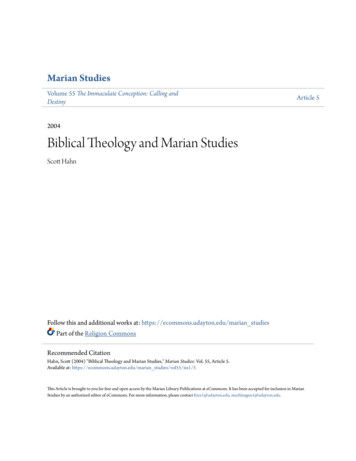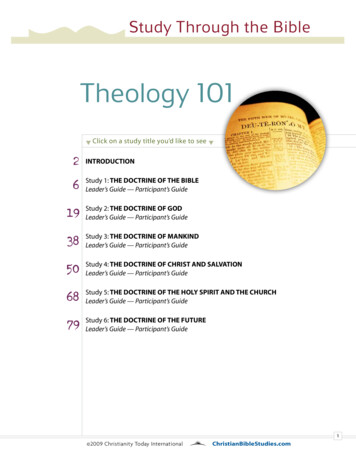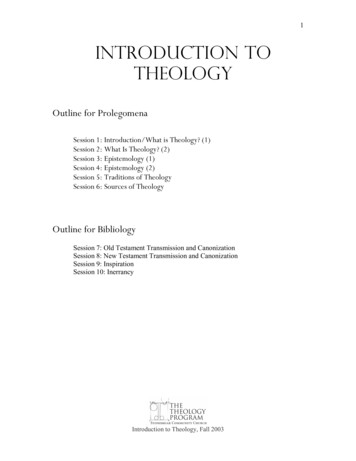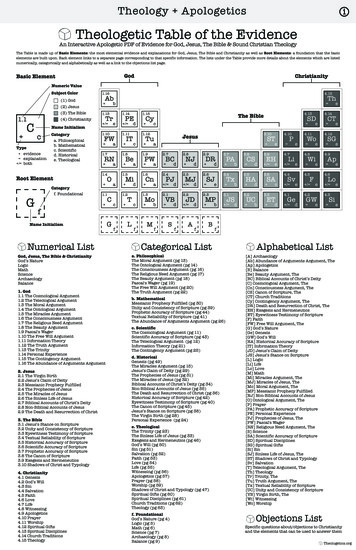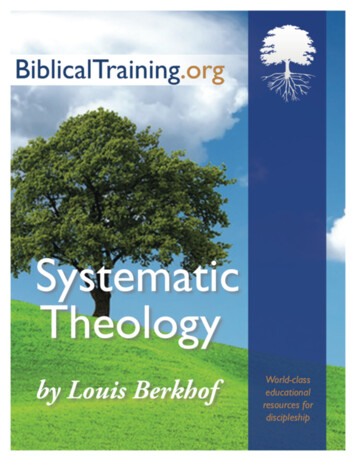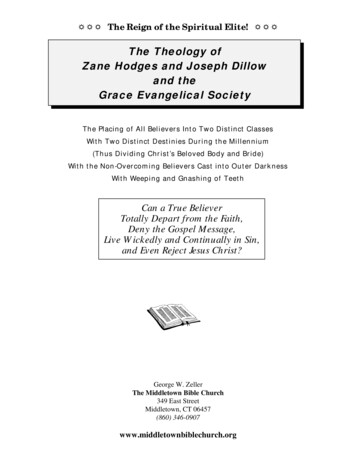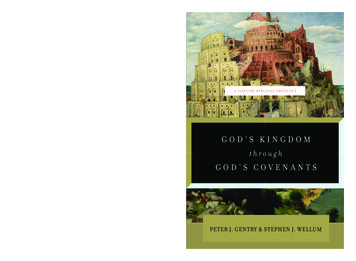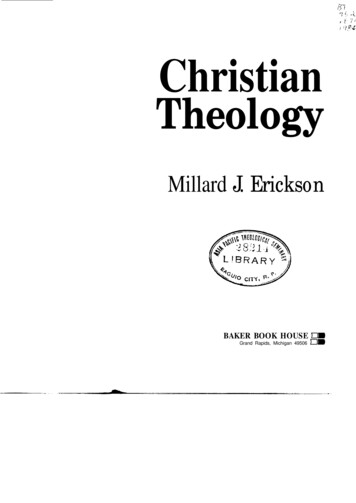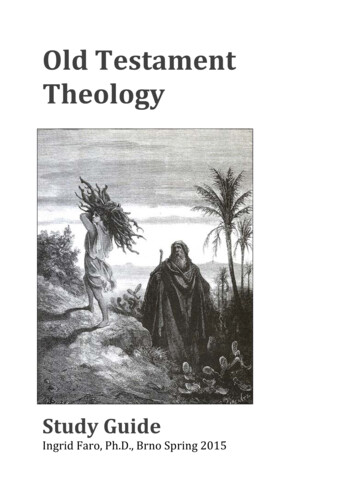
Transcription
oSpring2015
ContentsA. Introduction to Old Testament Theology1. Defining Theology and Old Testament Theology 72. Methods of Doing Old Testament Theology 103. Material for Doing Theology . 13Authority and Unity of ScriptureThe Canon4. Perspective for Doing Old Testament Theology . 15The Old Testament and the ChristianReading the LawReading the Prophetic Message5. Overview of the Old Testament 19Plan, purpose, and plotIntroduction to major themesB. Thematic Approach: Major Theological Themes of the Old Testament6. God . 21Creator, Monotheism, Names of God and LORDGod-Spirit-WordPresence: Garden, Theophanies, Tabernacle, Temple, Immanuel7. Creation . 24Creation by God’s Word and WisdomCreation as God’s Sanctuary: Tabernacle, TempleCreation as humanity’s nest8. Humanity . 25Image of GodIdentity, Purpose, and ResponsibilitySin, distorting the image of God: cause and consequences9. Redemption . 27Election: Blessed to be a blessing (Noah, Abraham-Israel, Moses,David, Jesus, Church)Covenant and Relationship: the Covenants of God (Noah, Abraham,Israel, Moses, David, Jesus, Church)Sacrifice and Atonement: Always about grace through faithReconciliation: the purpose of redemptionNew Creation: the completion of redemptionC. History of Redemption Approach: The Mission of God throughthe Old Testament10. Genesis: Creation through the Patriarchs 30Key Ideas: The biblical story of redemption begins with creation, andhumanity as the image and representative of GodMajor theological themes: Monotheism, Creation, Image of God,Abraham, Covenant, Land2
11. Exodus-Deuteronomy: Slavery, Exodus and the Wilderness . 32Key Ideas: Know the LORD, Exodus as a redemptive event, Covenantcommitment and renewal, Holiness of God and implicationfor His people, Wilderness as a testing event, Tabernacle asGod’s presence (with pillar of fire and cloud cover),Priesthood and representationMajor theological themes: Who is the LORD (protector, provider,holy, only God), Presence of God and Human Representation(image and intercessor), Reversal of sin (faith, sacrifice,obedience) and redemption12. Joshua-Judges: Promised Land through the Judges 32Key Ideas: God’s faithfulness in fulfilling His covenant promises,Conquest of the land, Obedience and Failure, God’sjustice and grace, Role of the Spirit of the LordMajor theological themes: Covenant and Land, Presence of God(God’s involvement in history), Conflict of Good and Evil(Doing evil or right in the eyes of the Lord)13. Samuel and Kings: Monarchy through the Exile . 33Key Ideas: Divine kingship, Human kingship (good and evil),Covenant with David, Prophetic voice as divine conscience,Worship of the LORD versus Baal (and other gods),Covenant blessings (through repentance and restoration)and curses (judgment and exile from the Land)Major theological themes: Covenant (Ark of the Covenant, andDavidic Covenant), Kingship, Presence of God, CharismaticLeadership, Pre-classical and Classical Prophecy14. Major and Minor Prophets: History through the Eyes ofthe Prophets 33IsaiahKey Ideas: LORD alone is God, Trustworthiness of the Lord,Divine sovereignty in judgment and deliveranceMajor theological themes: Holy One of Israel, Servant of theLord, Redeemer, EschatologyJeremiahKey Ideas: Law in the heart, God as potter, ExileMajor theological themes: God’s presence, God’s justice andrighteousness, New Covenant, False ProphetsEzekiel: God’s Eye View of HistoryKey Ideas: Lord’s sovereignty over the nations, Divine judgmentand human responsibility, Exile, Restoration of Israelunder Davidic kingMajor theological themes: “Son of Man,” Vision, HumanResponsibility, Apocalypse and Eschatology3
Minor Prophets: Echoes and Visions of That DayKey Ideas: God’s faithfulness and justice, Judgment on Israeland all nations (all nations held accountable to God),Pouring out of the Spirit, Day of the LORD,Social justice, Remnant will be saved, Restoration of IsraelMajor theological themes: Covenant, Justice, Faith, andRighteousness, Redemption and Restoration15. Psalms and Wisdom Books: Living and Reflecting on the Faith 34PsalmsKey Ideas: Torah faithfulness, Kingship of God, Praise and Worshipof God, Creation revealing God.Major theological themes: Davidic Kingdom, Kingdom of God,Creation, Worship, Ultimate victory of God over evilJobKey Ideas: Suffering and Sovereignty, Fear of the Lord,Major theological themes: Creation, Problem of evil, Knowing GodProverbs, Ruth, Song of Songs, Ecclesiastes, LamentationsKey Ideas: Wisdom, Covenant love, Faithfulness, Person ofExcellence, Vanity, Practical theologyMajor theological themes: Fear of the Lord, Trust in the Lord,Love the Lord, All other gods vainEsther, Daniel, Ezra, NehemiahKey Ideas: God working in history even when seems hidden,Endings and New Beginnings, Leadership in Crisis,Spirit empowerment, Practical and spiritual wisdomMajor theological themes: Exile and Return, Coming KingdomChronicles: “Let them go up!”Key Ideas: Centrality of Temple worship, Role of Priests and Prophets inthe kingdom, Evaluation of kings,Major theological themes: Worship, Faithfulness, Exile and ReturnD. Worldview Approach: How to live in a fallen world16. God’s Mission through Humanity: The Plot Conflict of Goodand Evil 36Theodicy: theological and philosophical problem of evilGoal: provide a framework for facing, evaluating, andresponding to evilBiblical theology, beginning in Genesis: (at least) four majorprinciples17. Principle of Action-Consequence . 36Biblical imagery: seedPrinciple: actions have consequences, unless intervention toalter their outcomePart of natural law God built into creation4
18. Principle of Authority and Responsibility . 37Biblical imagery: the image and likeness of GodPrinciple: humanity given key authority and responsibility touphold God’s rule in all realms of life in this universeGiven by God, betrayed and yielded to Satan, image and choiceremain, restored through Christ, available by beingtransformed into the image of ChristImportant key to overcoming evil19. Principle of Natural Law and Malevolent Forces 37Biblical imagery: sea monster (Gen 1:21) and serpent (Gen 3:1)Principle: some things are part of natural law that are good butcan cause harm, others are part of dark spiritual forceswith evil intentResponse to threat by natural law, natural disasters, “wild”animals, or other environmental factorsResponse to malevolent forces beyond natural law, recognizethe source behind the evil coming through human orspiritual entities20. Principle of Mercy and Grace 38Biblical imagery: a covering (kutonet), a covenant, and a signThis principle trumps (overrules) the other three: God givesmercy to the repentant, and grace to the faithfulFrom Genesis 3 through the rest of Scripture, this principle isfoundational to the character and will of God, tobring salvation, redemption, and reconciliation21. How Then Should We Live: Restoring the Image of God . 38E. Messianic Approach22. Bridge to the NT 38Old Testament: the “Holy Scriptures” in the New TestamentThe promise and plan of God23. Jesus: Lord and Messiah . 40Genesis 1-3 and JesusIn Genesis, Foreshadowed Noah, Abraham, JudahPredicted by BalaamExodus and JesusForeshadowed in the Davidic MonarchyMessiah in Ninth and Eighth century prophetsMessiah in Isaiah (Eighth century prophet)Messiah in Jeremiah, Ezekiel (seventh century prophets)Messiah in Daniel (sixth century prophet)Messiah in Zechariah and Malachi24. New Covenant fulfillment of the Old Covenant . 41The Abrahamic Covenant is fulfilled in the New Covenant –personal or family level covenant5
The Mosaic Covenant is fulfilled in the New Covenant –national level covenantThe Davidic Covenant is fulfilled in the New Covenant –dynastic, monarchial25. Future Hope 43Shadows and Cycles: The best of all possible worlds isyet to comeIsaiah and the End of Sorrow and ConflictDaniel and the Coming KingdomF. ConclusionsStudents’ Personal Reflection: write about something you have learned that has beensignificant to you this week6
A. Introduction to Old Testament Theology1. Defining Theology and Old Testament TheologyAlselm of Canterbury famously coined a meaning of theology in his motto “faithseeking understanding.” (fides quaerens intellectum) which “means something like anactive love of God seeking a deeper knowledge of God.”1 For those who love theLord, this indeed is our goal in theology, and in studying the Bible as God’s Word.!What is Theology? (This first page is a slightly modified review taken fromAnders Gerdmar’s New Testament Theology Study Guide, Fall 2014) 2o Theology means ‘knowledge about God’, theos, logoso For a secular academic, theology is the systematic study of the thought of e.g.,in the Old Testament or a certain texto For us, theology is the knowledge about God" theology is not only knowing what someone else said about God—evenif that is interesting," it is 1) knowing about God and 2) knowing God!However, we believe that we get to know God basically through the Bible—andnever against the Bibleo God has given us a Biblical framework for our relationship with him, to 1)know about Him and 2) to know Him (cf. the Hebrew work yada, used forboth ‘knowledge’ and e.g., the intimate relationship between husband andwife, Gen 4:1; Matt 1:25)o In scholarly exegetical work, we study what the Bible says about him.o Thus, theology is also a human intellectual work:" we formulate questions (What is the Old Testament theology ofatonement? Of covenant? etc);" we make exegetical investigations (e.g., word study, analyses of theoverarching ideas, historical background study) to answer thosequestions" we systematise, and even if we want to let the Old Testament govern theway we do it, our brains and traditions affect the systems we develop.o “Work with the Word of the Lord” (Acts 6:3) has happened from the first dayof the Church, and you who are called to the ministry has to become a work(wo)man of the Word (2Tim 2:15)o Paul sets for us an example of a worker in ‘Old Testament Theology’: Paulstudied hard. The ‘scrolls’ and text Paul had to study from was the JewishBible, our Old Testament. (2 Tim 3:16: Acts 26:24). He had a lifestyle ofstudy (2Tim 4:13), at the same time as he nurtured a close relationship withGod.o That is, there is a dialectic between study of the Bible and life in the Spirit1”SaintAnselm,” Stanford Encyclopedia of Philosophy, revised Sept 25, 2007. Accessed Feb 2, SeeUndChaPurAnsThePro2Except review from Anders Gerdmar, ”Study Guide for NT Theology,” Brno, Fall 2014.7
o N.B. There is no opposition between solid exegesis of the texts and yourknowing God intimately by the Spirit.!What is Biblical Theology, Old Testament Theology, New Testament Theology,and Jewish Biblical Theology?o Although we as Christians divide the Bible into New Testament theology andOld Testament theology, we must remember the Bible is one complete,unified book.o Biblical theology, deals with the whole Bible as one document through whichGod has revealed himself to us.o What is the difference between Biblical theology, New Testament theologyand Old Testament theology?" Biblical theology, basically, systematises the entire Biblical materialinto one system" New Testament theology systematises the theologies of New Testamentauthors individually and together. New Testament theology tries to seewhat’s ‘new’ in the revelation about God, that was often a mystery or ashadow in the Old Testament (Eph 3:8-11; Heb 8:4), written for ourinstruction and hope (Rom 15:4; 1 Cor 10:6-11). New does not mean that it never was there, only that it has beenrevealed (apo-kaluptô)" Old Testament theology systematises the Old Testament themes andideas in the different books of the OT separately, and together part of thewhole canon of Scripture.o What is the difference between Biblical Theology and Systematic Theology" Johan Gabler initiated a separation between “biblical and dogmatictheology” in 1787. He also began the division between historical/humanconcerns and divine/universal concerns.For Gabler, doctrines of God, sin, and salvation weredivine/universal concerns, which should be separated from issues ofhistorical concern or their relationship to modern events. Thisessentially segregated the Academy from the Church. (We will notbe separating these in our study of Theology!)This also created a divide between the Old Testament and the NewTestament, often segregating the OT to historical studies and the NTto divine concerns. This divide was deepened by this historicaloriented source-critical research, especially identified with JuliusWellhausen toward the end of the 1800’s that continued through thelast century and on into today.This system also robbed parts of the Bible of their authoritativestatus: if some of Scripture was viewed as “only” historical and lessimportant, less authoritative and more questionable than other parts,than the canon of Scripture itself was divided and the divine natureof the Word of God weakened.Systematic theology ideally gathers information from Biblicalstudies, history of church and dogma, but also includes the horizon8
out of which we do theology. A key goal is to identify major tenetsof the faith. Dogmatics, ethics, and the philosophy of religion areconsidered subdisciplines of systematic theology.Biblical theology is focused on detailed exegesis of passages thatcontributes to the overall interpretation of the books and authors ofthe biblical text of the canon, and unveiling revelation of God. A keygoal is to identify the major themes and key ideas in the story ofGod.Systematic theology is more dogmatic-prescriptive categorizationand itemized list. Biblical Testament theology is more historicaldescriptive big picture.o What is the difference between Old Testament Theology and JewishTheology (Theology of the Tanakh)?" Much of Christian Theology has held the New Testament as moreimportant than the Old Testament for various reasons, or has treated theOld Testament as unnecessary for reading or interpreting the NT,sometimes producing anti-Jewish readings of both the OT and NT." Marvin Sweeney states, “Fundamentally, Judaism is committed to arelationship with G-d as defined through divine Torah whereasChristianity is committed to the notion that its relationship with G-d isdefined through Jesus Christ.”3" Some of the differences are demonstrated in the order of the canon.Although they are the same books, the order of books in the two canonshapes the reading by the Jewish and the Christian communities.Jewish canon reflects the Jewish commitment to the Torah as thefoundation of divine relationship with God. The Former Prophets(Historical Books) disrupts the ideal of this divine relationship, forwhich the Latter Prophets lament, rebuke, call for return, and forseethe ideal. The Writings attempt to restore the ideal embodied in theTorah, begin with the Psalms which is structured into 5 Books thatrecall the Torah, and end with Chronicles and a return to the Land ofPromise, “let them go up!” to the Land.The Christian canon reflects the Christian commitment to thecoming and second coming of Jesus Christ, ending with the MinorProphets who, while warning, look to “that day” and end withMalachi “the sun of righteousness will arise with healing in hiswings ”The structure of the Tanakh points to the cyclical patterns of theideal life, disruption of life, and restoration of the ideal.The structure of the Old Testament points historically andprophetically to the revelation of Jesus Christ as the culmination ofhuman history. Sweeney observes:o Pentateuch recounts the early history of the world from creation throughthe patriarchs3Marvin A. Sweeney, Tanak: A Theological and Critical Introduction to the Jewish Bible. Minneapolish, MN:Fortress, 2012.9
o Historical Books recount Israel’s later history from Exodus to PromisedLand to Exile (Joshua through the Persian Empire)o The Wisdom and Poetic Books address “an eternal present in which thequestions of the meaning of life and worship of the divine are addressed”o The Prophets speak of Israel’s punishment for disobedience and “lookforward to the time of redemption.”4" The Tanakh is read by Jewish people in relation to the Jewish traditionsincluding rabbinic writings, with attention to defining their identity as aunique and holy people." The Christian Old Testament tends to be read first in relationship to theNew Testament, with a focus on fitting the OT into the themes of theNT (a Systematic Theological approach, or Historical Redemptiveapproach), often referred to as a Christologic or a teleologic perspective.o Problem of stripping the NT of its Semitic rootso Problem of reading Jesus and the NT as Greco-Roman rather than Jewish" Considerations in reading the Old Testament as Tanakh.2. Methods of Doing Old Testament Theology5!What is theology and how is it understood. Is biblical theology a tool of the church orof the academy, or both. What is the approach behind the different methodologies?Five Major Types of Biblical Theology:HISTORY . . Rooted in:Historical-critical Approach!Worldview- iterary ApproachTheory and practice differ between these Five Types of Biblical Theologyo Type 1: Biblical Theology as Historical Description" Purely historical and descriptive. No concern for application or relation to thepresent day faith or Christian practice. It is purely looking to discover anddescribe what the biblical text meant in its original, historical context (or, itsassumptions or conclusions about what the original historical context may havebeen).4Sweeney, ”The Task of Jewish Biblical Theology,” location 790-791.This section is largely from Edward W. Klink III and Darian R. Lockett, Understanding Biblical Theology: AComparison of Theory and Practice (Grand Rapids, MI: Zondervan, 2012), ”Introduction.”6Klink and Lockett, Understanding Biblical Theology, Chart and descriptions from ”Introduction.”510
" The goal is to seek and describe the theology, beliefs, and practices of thepeople “back then,” within their time, language, and culture. A canonicalapproach is not part of this method, nor a literary approach which considers theBible as a whole, unified text. The Old Testament and New Testament are notconsidered in light of each other." This type of theology can only be done within the academy, drawing fromhistorical, archaeological, and material culture and studies as an exegetical taskrooted in the biblical language." Its positive elements include:James Barr, John Barton and many others consider this to be the firststep, not the only step, in the theological process: we have to know whatthe text meant before we can rightly know what it means.Krister Stendahl sees the preacher’s task as being able to translate firstthe socio-historical language of the ancient text (the work done by theacademics) into the modern social location (the work done by thechurch, with the preacher representing the church)." Problems with this approachCan be presumptuous: we can be overly confident in our ability toanalyze the thoughts, intents, and worldview of ancient culturesCan neglect the larger corpus of the canon, either Jewish or ChristianCan read too much into other ANE literature, or give too much weight tonon-biblical sources in making interpretations, or reading back into thebiblical text.Stendahl criticizes scholars who emphasize this Historical descriptiveapproach as being subjectively convinced that they are capable of beingobjective scholars who only see the facts.o Type 2: Biblical Theology as the History of Redemption (Redemptive-Historical)7" This approach looks to history as it unfolds through Scripture to reveal thepurposes of God in a progressive process of revelation through time." Primary interest is the overall theological message of the Bible for the church.Requires sensitivity to literary reading. Christocentric focus. Requires view ofthe Bible as a unified narrative whole." Although this type is strongly historical, it is rooted in the concept ofredemptive history of the entire biblical canon. This approach follows thelinear, or chronological, development of the history of the story of redemptionbook by book through the Bible." The major themes often followed in this approach may include creation, sin,covenant, land, kingdom, redemption, and restoration, traced through thebiblical text.7In the textbook by Klink and Lockett, this approach is descriptive of D. A. Carson, similar to Geerhardus Vos,and Rosner.11
" This is also a scholarly, exegetical task, like Type 1, but has a focus also uponapplication for the church. The key themes are seen to all progress of God’sself-revelation leading towards the story of redemption." Dependent upon inductive, exegetical analysis of passages, building towardsgreater synthesis, ending ultimately in a systematic theology." There are at least three different “schools” within this one type.o Type 3: Biblical Theology as Worldview Story8" This middle category is literary and philosophical, looking for grand story inthe narrative text for the theological themes that bridge and connect the twotestaments." A major goal in this method is looking for the unity in the shape and plot ofthe Bible. Analysis draws from both the historical and the theologicalelements of the narrative to develop the overarching biblical worldview. Thisapproach appeals both to the academy and to the church in its meta-narrativeapproach." Rather than reading the Bible as one grand progressive unfolding narrative (asthe Historical-Redemptive above), this approach looks for the overarchingconnections between Old and New Testaments." Sets the passages of the NT within the context of the worldview-stories of theearly Christians and Second Temple Judaism." Some focus on the literary coherence of the biblical narrative, while othersfocus on reconstructing the historical world of the Bible." Encourages readers “to understand the individual episodes or passages ofScripture in light of its overarching story line. Instead of progressing from thesmallest bits and pieces of the narrative to the larger whole, (BT3, thisapproach) starts with the larger narrative portions of the text through whichindividual units are read.”9o Type 4: Biblical Theology as Canonical Approach10" Seeks to unite historical and theological approach. Rather than looking at thecanon of Scripture as a progressive revelation because of its sequence, itviews canon in light of being Christian Scripture.o Although the term “canon” is often used interchangeably with“Scripture,” these are used differently by some.o This approach is not a literary reading in terms of the plot structure ofthe whole Bible, but it is a theological reading of the whole Bible inlight of the Christian faith.8In the textbook by Klink and Lockett, this first methodology is descriptive of N. T. Wright, and some of itsproponents include Michael W. Goheen and Christopher J.H Wright.Klink and Lockett, chapter 5, ”Biblical Theology as Worldview-Story,” (location 1693 of 3853), italicsoriginal.10In the textbook by Klink and Lockett, this first methodology is descriptive of Brevard Childs. Childs uses theterm “canonical approach.” James Sanders coined the term “canonical criticism.” Others suggest a “canonicalconsciousness” in their theological approach, with focus on inner-biblical exegesis.912
" Can be considerable overlap between Type 3 and 4, since this approach alsoconsiders both the historical and the theological elements of the narrative. Theemphasis here, however, is to join the historical significance of the text withcontemporary application for the church." Blends academic rigor of what the text meant “back then” along with amodern contextualization. This approach produces more of a cross-canonicalblending towards the identification and development a theological theme ormotif." Important to this methodology is recognition of the shaping of the canon intoits final form. The canon itself becomes the overarching frame for thehistorical and theological interpretations of the Bible. Both academy andchurch are necessary in this process of establishing biblical theology." This approach is both academic, but also focused upon application by theconfessing community, the church. It is therefore both descriptive (historical)and prescriptive (theological), which is supposed to be lived, not just studied.o Type 5: Biblical Theology as Theological Construction11" This is a prescriptive approach that fits postmodern concerns." There is no interest or concern for the biblical passage’s ancient location orcircumstance." The predominant focus of this methodology is application by the church forthe confessing community, outside of the academy." Three basic approaches: the “revelational” approach, in which the text is readfor eternal truths regardless of the original context; the “textual” approachlooks for the symbolic world of the Bible as a framework for understandingthe contemporary world; and the “functional” approach places theinterpretation of the text into the hands of the contemporary believingcommunity – reader-response methodology – to give the text significance." Problems with this approach is subjectivity, and opening the door toindividual interpretations that may be far removed from the intent of theauthor or contextual purpose of the text.3. Material for Doing Theology!Authority of Scriptureo The biblical text itself, both Old and New Testaments, as well as ancient sourcesand traditions attest to the authority of Scripture, and continual regard for The Bookas a unified piece of divine inspiration, set apart from all other literature.12o Recognition of the unity of the biblical text, and its source of divine inspiration isrequired in order to form a truly Christian biblical theology.o The many methodologies that are used leads to a diversity of emphases.Nevertheless, as long as the foundation of approaching the Bible as divinely11In the textbook by Klink and Lockett, this methodology is descriptive Francis Watson.See R. Beckwith, The Old Testament Canon of the New Testament Church (Grand Rapids, MI: Eerdmans,1984.1213
inspired unified text is present, the diversity of methodologies will form a mosaicto appreciate the application of the biblical text to our personal lives and mission.!Problems with historical criticism and reasons to incorporate literary reading.Is the Bible a whole book or a “rag-bag” collection?13o The historical-critical method created a “hermeneutic of suspicion” toward theBible." Scholarship claimed that the Bible, especially the Old Testament, was simplya cut-and-paste collection of multiple sources, compiled by Jewish peoplewith ideological motives for their own political or religious agendas." People became highly skeptical or cynical about the Bible as the authoritativeWord of God." This has led many to wrongfully believe that the Old Testament is full oferrors, and was corrupted along the centuries of rewriting so that we cannottrust what is written." Furthermore, for many decades, the idea of the Bible as a unified work waslost, and people in both the academy and in the church succumbed to readingthe text of Scripture as isolated sound bites, a collection of disjointed writingsand recorded sayings that contradicted each other, forming into a confusing,nearly unreadable or indiscernible mess, lacking a coherent message.o In the last decades, parts of scholarship turned to looking at the individual books ofthe Bible as a whole through the literary approach, and also to looking at the Bibleas a whole through the canonical approach." These methods have proven the unity of the books of the Bible, and theirinter-relationships to one another, while pointing out some of the errors in thehistorical critical approach." This brought a corrective to the historical critical method.!Literary Approach to Biblical Theologyo Better able to grasp the big picture, the Drama of Scripture.o By analyzing plot and theme we can more clearly see the grand theologicalnarrative, retold and re-envisioned through the span of theological texts.o Literary studies in more recent decades have demonstrated through multiplemethodologies that while recognizing that sources were used in writing andcompiling the Old Testament, that there is a clear unity, a cohesive story, and aconsistent messages. The grand narrative, and major themes artfully weavethrough the various books of the Bible.o Related patterns of creation-uncreation-recreation, of rebellion-exile-return, and ofsin-repentance-redemption recur throughout Scripture. The interweaving ofbiblical texts, and the interplay of imagery and story, create a grand narrative ofthe mission of God from opening chapter to close: the drama of redemption.13Dempster, ”Chapter 1,” Dominion and Dynasty.14
!The Canono We will be using the Jewish organizational structure of the Hebrew Bible, as usedin Dominion and Dynasty. As Rendtorff notes, Christians rarely read the OldTestament in its final Jewish order, even though this was likely the one that Jesusand the early church read.14o Brevard Childs notes that “the ‘story of faith’ was largely preserved in historicalsequence (Genesis through Ezra) along with a variety of ‘commentary’ (Psalms,Prophets, Wisdom).”15o The Christian arrangement emphasizes eschatology, The Jewish arrangementemphasizes ethics and return to the Land (the restored Jewish commu
o Theology means ‘knowledge about God’, theos, logos o For a secular academic, theology is the systematic study of the thought of e.g., in the Old Testament or a certain text o For us, theology is the knowledge about God " theology



